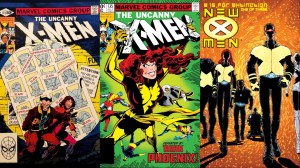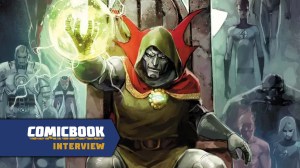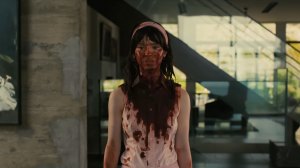The world of horror comics has delivered readers all manner of ghosts and goblins, making it incredibly difficult for comic creators to offer audiences unique experiences. Luckily, writer Christofer Emgård and artist Tomás Aira took note of what the genre was lacking and created The Whispering Dark, a four-issue series that debuted last October. The pair launched a journey that began by depicting the real-world horrors of war, only for the book’s characters to fully descend into a horrific nightmare full of both psychological and supernatural horrors.
Videos by ComicBook.com
The Whispering Dark has been collected into a trade paperback by Dark Horse Comics, which is on sale now. In the book, “An Army pilot confronts a supernatural horror in this thriller in the tradition of Lovecraft’s At the Mountains of Madness and Coppola’s Apocalypse Now! Hannah Vance believes her faith in God can survive anything. But when her helicopter is shot down behind enemy lines, she will fight and kill on an ever-more-savage battlefield, desperate for a way home. On the horizon, an evil waits for her–and freedom, of a sort.”
ComicBook.com recently corresponded with both Emgård and Aira via email to discuss their inspirations for the harrowing journey and how they aimed to break the mold of horror comics.

ComicBook.com: How did the idea for this project first come together, and how did you two discover that you had found such a great collaborator to move forward on the project?
Tomás Aira: The idea and plot of the book was ready when I arrived to the project, I loved it immediately as it had the things and themes I enjoy most drawing and it combined them masterfully. It was so finetuned to what I wanted that I thought, “If this is the project Christofer wants to do, we must be on the same page.” And we are!
Christofer Emgård: Wars are terrible, and at the same time utterly human. We have this bottomless capacity for inflicting hurt and suffering on one-another which continues to astound and disgust us, and yet we can’t seem to stop. Why is that?
When I first pitched The Whispering Dark to Dave Marshall at Dark Horse the story had been simmering in the back of my head more than twenty years. It was my attempt to answer the question above, while also catering to my infatuation with otherworldly horror. Dave helped bring the whole thing into focus, and he was also the one who first put me in touch with Tomás.
I was immediately impressed with the work Tomás had done on War Stories and I felt very fortunate when he expressed interest in doing The Whispering Dark. And that was before I knew about his deep love of horror. When I later saw his character studies and first pencils I realized that we’d truly hit jackpot, and it’s been a great ride since. The first of many, I hope.
The book feels very personal and intimate. Did either of you draw from personal experience to motivate your work? If not, were there other creators/writers/artists who influenced the book’s tone?
Aira: I used to go camping and the woods and forests are something visually very interesting that I try to convey in the book, the irregular and the chaotic of the wild. I also draw much of my inspiration from artists that do that very well like Alex Alice and Matthieu Bonhomme if I had to name a few.
Emgård: As a kid I was captivated by all things military, and as an adult I’ve tried to understand why. What is the allure? In the story Hannah struggles to reconcile her expectations of war with the actual experiences of it, and in a way her thoughts and growing confusion echo my own. I’ve never served, so I can never know for certain, but I suspect I my journey would be all too similar to hers, had I been thrust into a similar situation.
My main inspirations have been Heart of Darkness and Apocalypse Now, and also Jacob’s Ladder, which is one of my favorite horror flicks. The tone of this story owes much to them.
While there are many horror books out there, The Whispering Dark stands out for being far more unsettling due to its focus on the military. How did you find the right balance between telling a mature, dramatic story while avoiding common horror beats/imagery that might make another book a more “fun” experience for the reader?
Aira: Of course, for most of the tone of the story I give credit to Christofer. I felt that the atmosphere and moods the story needed were a match of what I can draw and what I wanted to test in coloring, as this is my second book I colored myself. My visual range is not very wide, so this was a case of focusing on my strengths to give the story the art it needed.
Emgård: The early versions were actually way campier, focusing more on a string of bizarre, supernatural incidents with the war being just a backdrop. But with each successive draft the tone grew more serious, as I found that the only way to do the setting justice was to fully embrace the harsh reality of war itself. The otherworldly aspect then grew from there.
I did worry that the book would end up being too dark emotionally, but at the same time I didn’t want to pull any punches. It’s been immensely gratifying to see the result resonate with readers.
The book feels like it’s only offering a glimpse into a much bigger, darker world. When developing the book, did you flesh out all of those bigger ideas that helped inspire the book or did you only conjure the necessary elements as they related to the story? Is it possible we could see another story unfold in the world of this mythology?
Aira: We were just conjurers this time around. I have my own vision and ideas of the world “behind” The Whispering Dark and I sketched some of it looking for the right look for the landscape and monsters, but I did not dive into it too much outside what the story needed, I hope we can see more of it in the future, I want to dig deeper!
Emgård: There is absolutely a larger, darker world out there, and it’s definitely a world I aim to revisit. Some of it has been developed over many years, while other aspects have only been briefly sketched so far, but there’s plenty of room for more tales. And I really hope to see more of it interpreted through Tomás’s art.
Lastly, with the book having such dark subject matter, how would you get out of such a dark creative space? Is a more lighthearted project on the horizon or will you keep going deeper into the things that frighten you?
Aira: I’m fascinated by these dark ideas and seek them out in other people’s work, I don’t live in a dungeon tough and work mostly with sunlight, so I guess that keeps my mind away from these dark energies. I have always other stuff to draw on the side, I can’t help it, and if I’m getting too deep into the darkness, I just change gears for an hour or two. Right now, I’m drawing a comic about a theater play with three girls and a guy in an apartment, so mostly a light tone. Though it has a dark moment, it’s a sitcom compared with The Whispering Dark!
Emgård: I’ve realized over the years that I’m quite the optimist, somewhat to my own surprise, and so it doesn’t take that much to lift me up. A nice playlist or a cozy ’80s movie can be enough to dispel the shadows when needed. At the same time, I seem to have this obsession with plumbing new depths of terror and darkness in my writing, so maybe that’s my way of channeling the angst of living in this day and age.
Looking at all the different stories I’m currently working on, the vast majority are quite somber, and I will probably never write a comedy, but who knows …
*****
The Whispering Dark trade paperback is available now.





